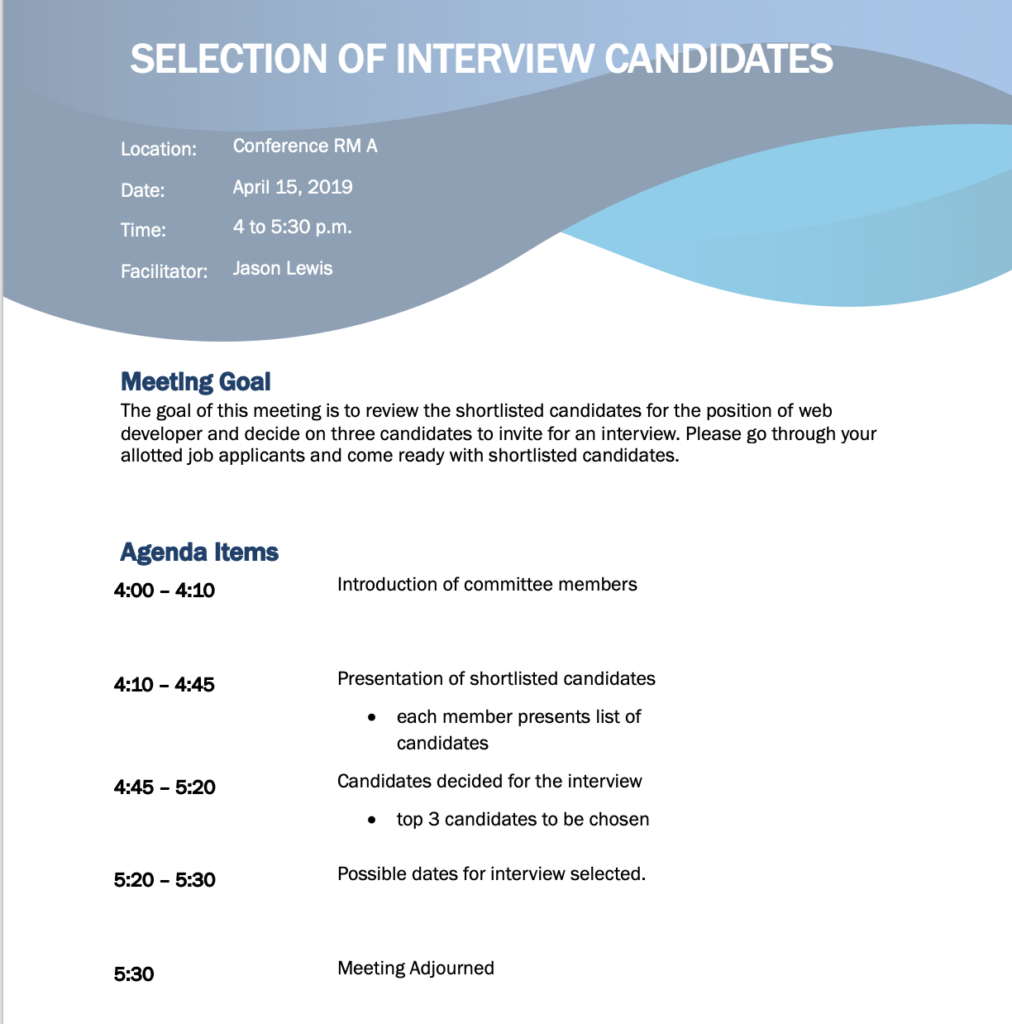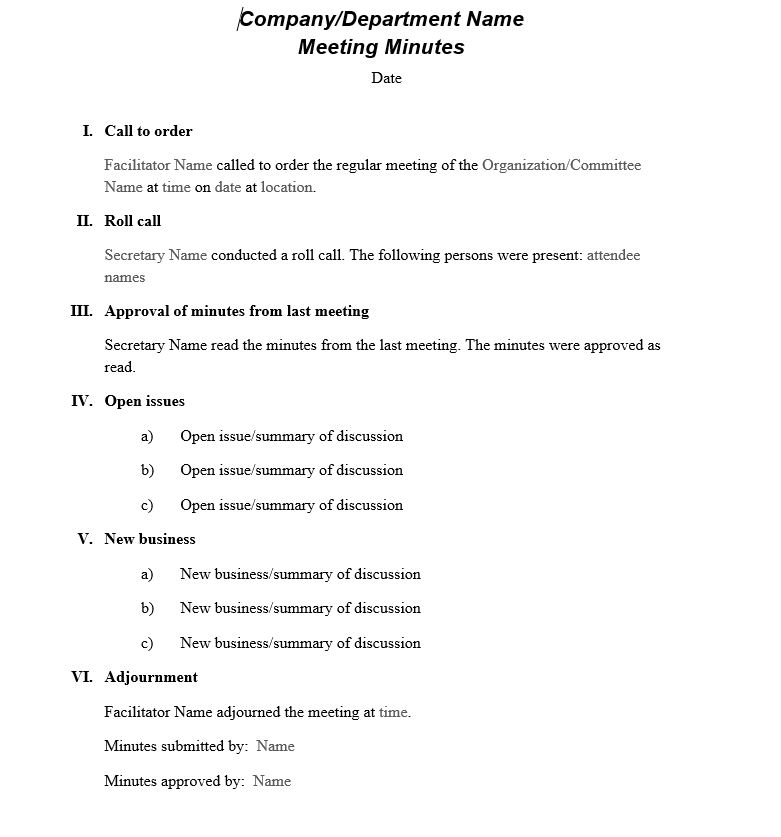Meetings and Agendas
KATRINA WEBKAMIGAD AND YVONNE ABITONG

Photo by Campaign Creators on Unsplash
LEARNING OBJECTIVES
- Create a meeting agenda
- Identify elements of a formal agenda
- Take minutes during a meeting
- Identify elements of formal meeting minutes
AGENDAS
Agendas are used to organize meetings, keep track of old and new content, gives a time frame for what items are to be discussed and provides a clear understanding of a common end goal for the participants. Agendas hold important dates and content, plus they provide guidance and preparations for the following meetings.
What is a meeting Agenda?
- A meeting Agenda is a list of components and goals that participants are to discuss and hope to accomplish during a meeting
What is the purpose of an Agenda?
- To outline the main ideas of any events, responsibilities and deadlines that must be further discussed and determined.
How to Develop an Effective Agenda
- Create an agenda
- Identify the five W’s (Who, What, When, Where and Why?)
- Items of discussion
- Goals of the meeting
- Provide any readings or documentation that will prepare your participants for what is expected
When can an Agenda be used?
- An agenda can be used anytime there is a big event, interview times and dates, work schedules or school schedules, conferences etc.
Structure and Format of an Agenda
- Daily Planner
- Timetable
- Syllabus
The blueprint for any meeting is the agenda document. It contains the following:
- The time, date, location, list of participants, purpose statement, call to order identifying the person chairing or leading the meeting
- Introductions if there is even one new participant in the group
- Roll call listing the participants expected, which can be silently checked off by the participant in charge of recording minutes; a note is made beside the name of any absentees so that a list of actual participants is ready for the minutes
- Approval of the minutes, where corrections to the previous meeting’s minutes (sent out soon after the previous meeting) are suggested by participants who were there before the minutes are approved by the group for official archiving
- Old business for discussing any issues left unresolved (“tabled”) in the previous meeting
- New business listing topics for discussion in order of priority so that the most important issues can be dealt with first so that items of lesser importance don’t push the important ones off the agenda and into the next meeting if the lesser items end up taking longer than expected
- The expected length of time is indicated for each item, with contentious items getting extra time to accommodate the depth of discussion expected.
- Items may include proposals for new initiatives, brief presentations reporting on recent developments or existing initiatives, and discussions about recent or upcoming developments
- Any preparatory work is indicated such as readings (e.g., reports that will be discussed) or reports that must be presented by individuals.
- Adjournment for discussing when the next meeting shall take place
Figure below provides an example of a meeting agenda.

Running a Meeting
Introduction
Make your objective clear. A meeting must have a specific and defined purpose. Before you send that calendar invite, ask yourself: What do I seek to accomplish? Are you alerting people to a change in management or a shift in strategy? Are you seeking input from others on a problem facing the company? Are you looking to arrive at a decision on a particular matter?
In order to conduct an effective meeting, You also need to have an agenda. An agenda usually contains the following elements:
- Call to Order
- Roll Call
- Reading/Approval of Minutes
- Officer’s (and others) Reports
- Committee Reports
- Unfinished Business
- New Business
Stick to your schedule. Create an agenda that lays out everything you plan to cover in the meeting, along with a timeline that allots a certain number of minutes to each item and email it to people in advance. Once you’re in the meeting, put that agenda up on a screen or whiteboard for others to see. This keeps people focused.
Start on time, end on time. If you have responsibility for running regular meetings and you have a reputation for being someone who starts and ends promptly, you will be amazed how many of your colleagues will make every effort to attend your meetings. People appreciate it when you understand that their time is valuable. Another note on time: Do not schedule any meeting to last longer than an hour. Sixty minutes is generally the longest time workers can remain truly engaged.
Follow up. It’s quite common for people to come away from the same meeting with very different interpretations of what went on. To reduce this risk, email a memo highlighting what was accomplished to all who attended within 24 hours after the meeting. Document the responsibilities given, tasks delegated, and any assigned deadlines. That way, everyone will be on the same page.
Meeting Minutes
Bookends hold books up. Without them, the books tumble onto each other or off the shelf. The “bookends” of a meeting, likewise, are as important as the meeting itself. Without them, nobody knows beforehand what’s going to happen or remembers afterward what did. We’ve discussed the first major bookend of a meeting, its agenda. In this section we’ll turn our attention to the kinds of bookends that follow a meeting, including principally its minutes.
The Why and How of Meeting Minutes
Among the exasperating experiences in group meetings are moments when people say, “We talked about this before—at least twice. Why are we going over the same ground again?” There are also those times when we hear, “John, you were supposed to report on this. What’s your report?” and John replies, “But I didn’t know I was supposed to make a report.”
Whether we like or believe it or not, our individual impressions of a meeting start changing and diverging the moment we leave the site. As one business writer noted, “Even with the ubiquitous tools of organization and sharing ideas…the capacity for misunderstanding is unlimited.”Matson, E. (1996, April-May). The seven sins of deadly meetings. Fast Company, 122.
Effective meeting minutes include the following:
- Date, location, time (start/stop), participants in attendance and those absent.
- Detailed account of significant discussion points and decision(s) made.
Minutes should be written for an audience needing to know what was discussed at a meeting. You dont have to capture everything everyone said in the meeting (like a transcript), but you should capture the essence of the discussion.
Good Example: The group talked about various types of fundraising events, and narrowed its focus to those that have a low overhead and are family friendly. Ideas that will be explore more fully include a fun run/walk, block party, and pony rides.
Bad Example: The group talked about fundraising.
- Action items.
Things that need to be done by meeting participants after the meeting need to be called out and identified as action items. Each action item should be set off on its own line, and include the task, who is responsible for the task, and when the task will be done.
Examples
Action item: All participants will write up a personal bio and submit it to HR by June 2, 2025.
Action item: Ted will contact the legal department to get guidelines for our new policy and email the information to the group by next Tuesday.
- Next steps
Summary of plans and procedures for the group.
Example: Members will work on their action items, and come to the next meeting ready to share out with committee. Committee chair will schedule the next meeting, and circulate the draft minutes for review and approval.
Recording minutes during the meeting
Recording communication in “real time” during a meeting is definitely a skill that takes practice. Below are some suggestion that help minute takers stay on track during the meeting:
1.Get the agenda
Before the meeting, get an agenda from the meeting facilitator so you can prepare yourself for the topics, and make a template to fill in during the meeting.
2. Decide what method of transcription works best for you
Some people like to record minutes on their computer during a meeting, while others like to take notes on paper. Decide what method works best for you. If you are considering tape-recording the meeting to help you fill in details when crafting the actual minutes, you should get consent from the meeting participates. Some states (e.g., Washington State) have informed consent laws about tape recording people.
3. Have plenty of space to record notes
Whether you chose to create a template based on the agenda or not, you will want to make sure you have plenty of room to record your minutes. Not everything you write down will go into your finalized minutes, but a good minute taker captures as much as they can during the meeting.
4. Record facts, not interpretations
While taking minutes you want to make sure that you record what people say, not how you feel about their statements. For example, you would write “Stacey suggested we all donate money to the food bank” as opposed to “Stacey had the ridiculous idea that everyone donate to the food bank.
5. Focus on major issues, actions and decisions, not on every comment made.
Your goal is to capture the bases of the discussion, not create a transcript. Action items need to be detailed and specific, but the rest of the minutes can summarize the general gist of the discussions.
6. Make sure you have the meeting participants and their names recorded accurately before the meeting adjourns.
7. Identify yourself as the minute taker
It is important to put your name at the bottom of the minutes, in case anyone needs to ask a clarifying question or request edits to the minutes.
Examples
Respectfully Submitted by [your name]
Have the meeting facilitator (or yourself as the person recording minutes) distribute minutes promptly. When and how you disseminate minutes shows whether and how much you care about what your group does. If your group has bylaws, it may be a good idea for them to include a time frame within which minutes of meetings need to be distributed (such as “within five days”).
Make sure your mailing list of people to receive minutes is up to date and accurate. This will ensure that no one misses the next meeting because he or she didn’t see when and where it was scheduled to take place.
Sloppy minutes degrade the value of the work and time people invest together. They can also weaken a group’s morale. Professional minutes, on the other hand, may even make people who weren’t at a meeting wish they had been—although that’s perhaps asking a lot, unless you served pizza!—and can strengthen your group’s pride and solidarity. As with meeting agendas, there are a wide variety of sample meeting minutes to review. Here’s a link to a Google search for meeting minutes.
What Else?
If you’re the leader of the group, making sure that minutes are prepared and distributed well is only one step toward increasing the likelihood that your meetings will achieve their full potential of transmitting discussions into plans and plans into action. You should do three other things after a meeting.
First, you should contact group members who were identified in the minutes as being responsible for follow-up action. See if they need information, resources, or other help to follow through on their assignments. If a committee or subcommittee was asked to take action on some point, get in touch with whoever heads it and offer to provide materials or other support that may be needed to accomplish its work.
Second, you should set a positive example. Take a few minutes to reflect on how effective you were in facilitating the last meeting and ask yourself what you might change at the next one. Be sure, too, to implement any decisions in a timely fashion that you as the leader were given.
Third, you should make sure that the minutes of your group’s meetings are stored in secure form, either physically or digitally or both, so that they are available to both you and other group members at any time. Your group’s institutional memory, which is the foundation for future members to build upon, needs to be tended regularly and diligently. When in doubt, it’s better to hold onto information and documentation related to your group. Discarding something because you think to yourself “nobody will forget this” may very well turn out to be a mistake.
Observing these suggestions may not make the experiences associated with following up on group meetings heavenly, but it might at least keep them from being too hellish.

Formal Meeting Minutes template available in Microsoft Office
Informal Meeting Minutes Example
Law Minutes- January 19, 2019
Attendees: Katrina Webkamigad, Sabrina Trudeau
Missing: Yvonne Abitong
Agenda: Discussing about the presentation for Law
Action and Tasks: Discussed the presentation and figure out who’s going to write what and discussed about researching we found and compared each others’ ideas. Also discussed when we would meet up group.
Main Points: Discussing the roles in the group project, discussing the topic of the Ombudsman, giving task/responsibilities on who will research what.
Future Decisions: next meeting we will discuss what everyone researched on, and get started on the PowerPoint to input our information.
Page Attribution
EXERCISES
- Review the minutes of 3–4 recent meetings of a local governmental agency such as a city council or parks commission. What portion of the text in each set of minutes, if any, do you feel could be eliminated without diminishing the effectiveness of the documents as records of the meetings? Write up a revised version of one of the sets of minutes which most efficiently conveys what was important in the meeting.
Candela Citations
- Chapter 16: Meetings and Web Conferencing. Authored by: Jordan Smith and Venecia Williams. Located at: https://pressbooks.bccampus.ca/businesswritingessentials/chapter/11-3-group-meetings-and-web-conferencing/. License: CC BY-SA: Attribution-ShareAlike
- ORGANIZATIONAL COMMUNICATION ANTHOLOGY: 2.9 Meeting Minutes. Authored by: Anonymous. Located at: https://textbooks.whatcom.edu/cmst245/chapter/2-9/. License: CC BY-NC-SA: Attribution-NonCommercial-ShareAlike
- Writing in Community and Justice Services. Authored by: Katrina Webkamigad and Yvonne Abitong. Located at: https://ecampusontario.pressbooks.pub/writingcorrections/chapter/chapter-6-meetings/. License: CC BY: Attribution
